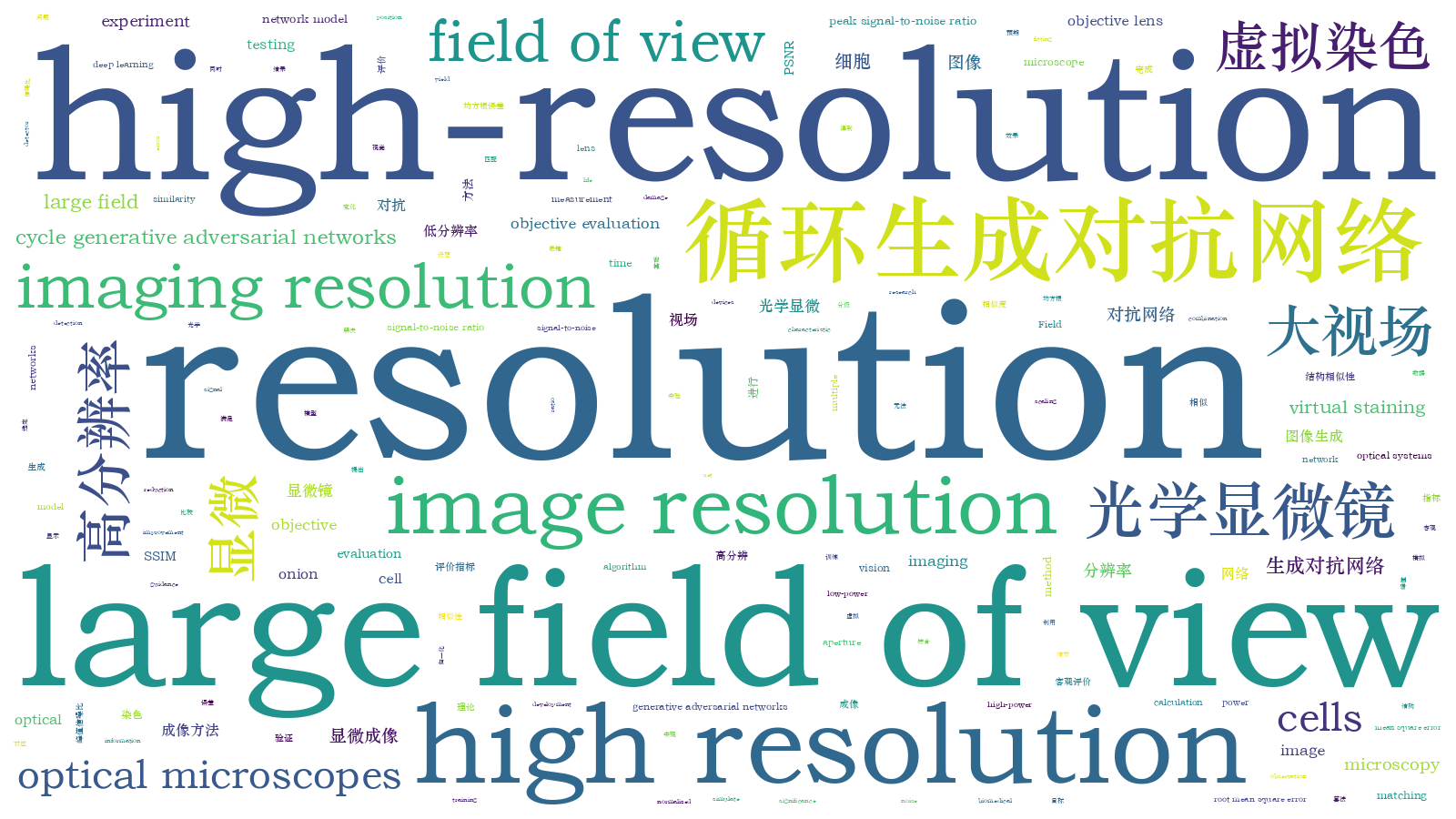基于循环生成对抗网络的大视场显微成像方法  下载: 521次
下载: 521次
In traditional optical microscopes, large field of view and high resolution cannot be achieved at the same time. Large numerical aperture objective lens is necessary to obtain high-resolution images, which will inevitably lead to the reduced imaging field of view. Similarly, a small numerical aperture objective lens should be employed to obtain a large imaging field of view, and the corresponding imaging resolution will inevitably decrease. Therefore, when the traditional optical microscope is adopted, a trade-off is needed between imaging resolution and imaging field of view, and it is impossible to obtain large field of view and high-resolution microscopic images simultaneously. With the rapid development of deep learning technology, different algorithm models are designed based on deep learning, and the corresponding pathological cell models are diagnosed in combination with the evaluation and guidance of professional doctors to yield computer-aided calculation and detection effects. Therefore, this paper proposes a method to generate matching high-resolution virtual stained images from low-resolution stained images with large field of view using cycle generative adversarial networks (Cycle-GANs), without changing the optical systems and detector devices. Only ordinary microscopes are employed to obtain staining images with large field of view, and it is unnecessary to convert the multiple objectives to obtain high-resolution images. Virtual high-resolution staining images at any position of the large field of view can be predicted through network model calculation, and the high resolution and large field of view can be realized at the same time.
In this paper, Cycle-GANs are employed to complete the experiment. Firstly, the data set preparation is carried out, and the unpaired and paired data sets of images under multiple objectives are collected respectively to constitute the training and testing parts of the network model. Secondly, a theoretical pre-experiment is conducted. The resolution of the same stained onion epidermal cell images is scaled to simulate the reduction of image resolution. The resolution of the input images is verified to have a lower limit, and the field of view of the microscope cannot be infinite in actual observation. Then, through imaging and testing the resolution testing board, the experiment of generating 25 times high-resolution virtual images from 10 times low-resolution images is carried out, which proves that Cycle-GANs networks can improve the image resolution. Finally, experiments are carried out to generate 25 times high-resolution virtual staining images corresponding to 10 times and 4 times low-resolution real staining images using stained onion epidermal cells. The corresponding values and results are obtained through subjective vision and objective evaluation indicators.
In the experiment of grading and scaling the resolution of the same stained onion epidermal cell images (Fig. 4), the fitting curves of structural similarity index (SSIM) and peak signal-to-noise ratio (PSNR) decrease with the reducing image resolution, while those of normalized root mean square error (NRMSE) increase with the decreasing image resolution (Fig. 5). With the resolution reduced by 32 times, the SSIM value lower than 0.5, and the PSNR value lower than 20, the images can no longer be correctly resolved by human eyes, which proves that the image resolution cannot be infinitely reduced. Then, in the experiment of generating 25 times high-resolution virtual images from 10 times low-resolution images on a resolution testing board (Fig. 6), low-resolution images under 10 times objective in the second row in Fig. 6 are generated by the algorithm as shown in the third row in Fig. 6. The sets of the fourth column and fifth column of the resolution testing board can be well resolved by human eyes, which shows the improvement of image resolution. Finally, in the experiment of generating 25 times high-resolution virtual stained images corresponding to 10 times low-resolution real stained images of onion epidermal cells (Fig. 7), the maximum SSIM, the maximum PSNR, and the minimum NRMSE are 0.684, 23.523 dB, and 0.131, respectively. In the experiment of generating 25 times high-resolution virtual images from 4 times low-resolution images (Fig. 8), the SSIM and PSNR can be as high as 0.597 and 22.322 dB, and the NRMSE is as low as 0.180. Under the analysis of subjective vision or objective evaluation indicators, the results of virtual stained images generated based on Cycle-GANs are close to those of real bright-field stained images under the measurement of various indicators.
Traditional optical microscopes cannot combine large field of view with high resolution. Therefore, this paper proposes a method to generate matching high-resolution virtual stained images from low-resolution stained images with large field of view by Cycle-GANs. This can transform low-resolution stained images with low-power bright field into matching high-power virtual stained high-resolution images. Experimental results show that the characteristic information, such as organelle structures in the bright-field stained images of onion epidermis cells, can be extracted effectively by Cycle-GANs. Finally, virtual cell staining is realized, and staining damage to the tissues is reduced. Additionally, the large field of view and high resolution of the traditional optical microscope can be considered at the same time by inputting low-resolution stained images with a large field of view and outputting high-resolution virtual stained images with a high similarity to high-resolution real stained images with a small field of view. Finally, the differences between the generated virtual stained images and real bright-field stained images are evaluated by subjective vision and objective evaluation indicators. The results show that the virtual stained images generated by Cycle-GANs and real stained images are highly similar under the measurement of various indicators. Therefore, this method can meet the large field of view and high resolution of traditional microscopes. When applied to real life, it can reduce the costs and the burden of doctors and is of great significance in biomedical cell research.
付娆, 方宇, 杨勇, 向东, 吴晓静. 基于循环生成对抗网络的大视场显微成像方法[J]. 光学学报, 2023, 43(5): 0518002. Rao Fu, Yu Fang, Yong Yang, Dong Xiang, Xiaojing Wu. Large-Field Microscopic Imaging Method Based on Cycle Generative Adversarial Networks[J]. Acta Optica Sinica, 2023, 43(5): 0518002.







